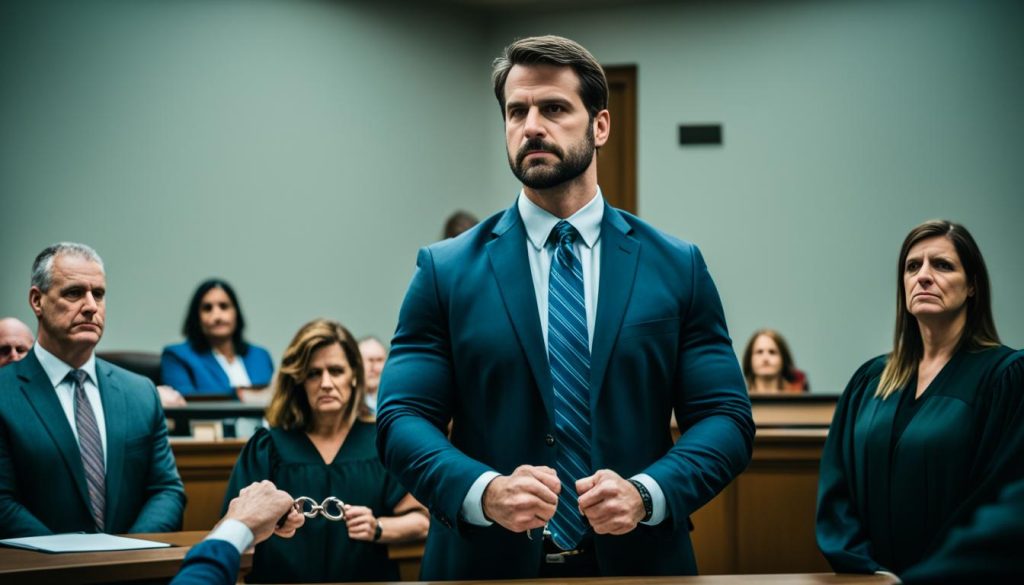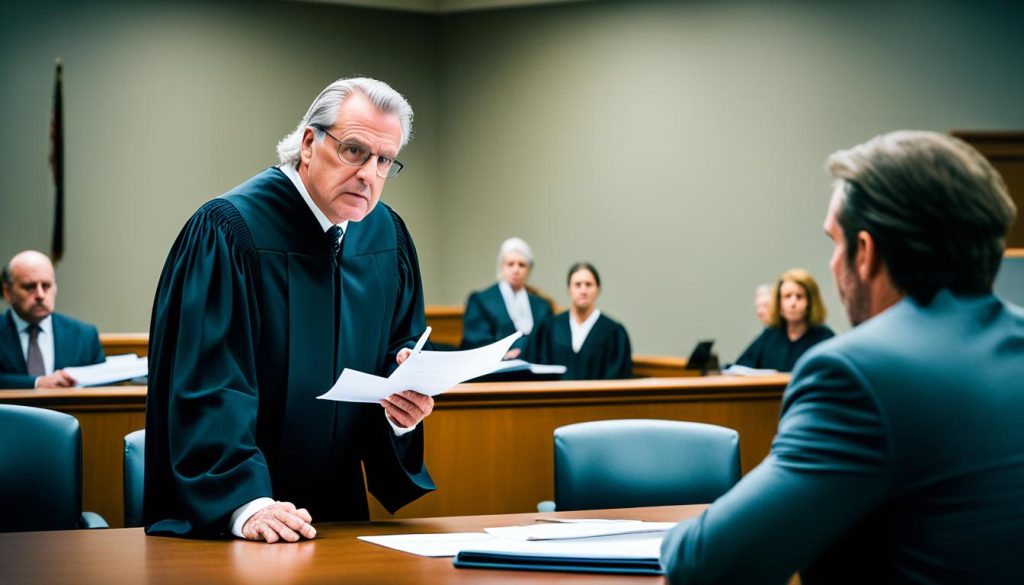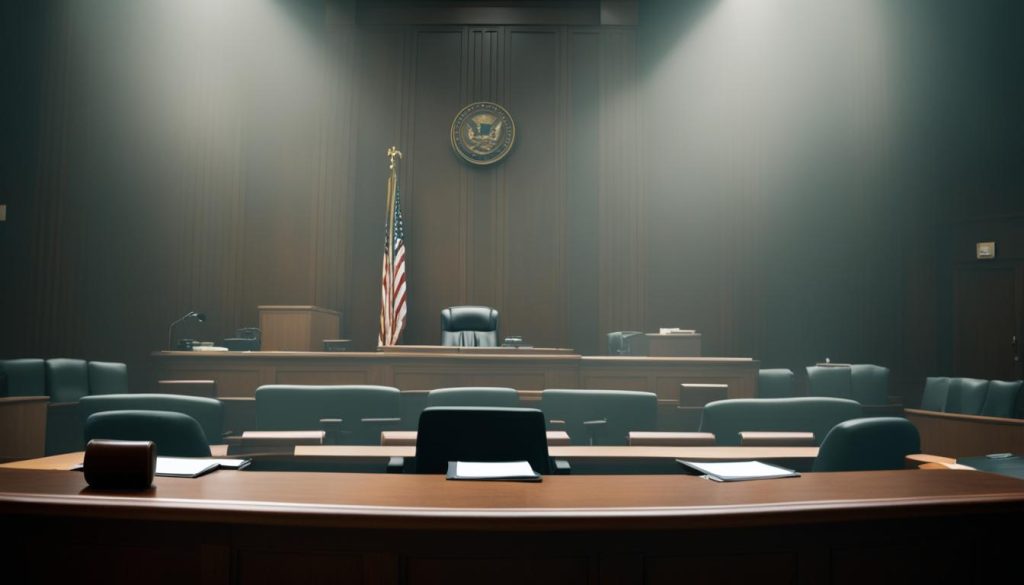When you or someone close to you faces criminal charges, the idea of a trial can feel overwhelming. Knowing about the criminal justice process and what happens in court can make things clearer. As a crime victim, you have rights. These include applying for compensation, attending proceedings, getting protection, and being heard1.
In a criminal trial, the defendant must be in court, especially for serious crimes1. Trials often have a jury of twelve people, sometimes with extra members for emergencies1. Every federal trial is recorded by a court reporter, so everything is documented1.
Court deputies are key in trials, swearing in witnesses and keeping the courtroom calm1. In civil cases, defendants can be in court but don’t always have to be1. Witnesses give their testimony on the facts of the case1.
Sometimes, a trial is decided by a judge alone, without a jury1. Lawyers try to show their client in a good light and prove they’re innocent1.
Key Takeaways
- Defendants have the right to be present in the courtroom during criminal trials.
- Criminal trials typically involve a jury of 12 members, with the possibility of alternate jurors.
- Court reporters record every word of the trial proceedings for the official record.
- Court deputies administer oaths to witnesses and help maintain order in the courtroom.
- In some cases, a judge may determine the facts and decide the outcome without a jury.
Understanding the Criminal Justice Process
Arrest and Charges
When the police arrest someone, they take them to jail. Then, one of three things happens: the defendant is released if the prosecutor decides not to file charges2. Or, the defendant posts bail or is released based on a promise to appear in court later for arraignment2. Or, the defendant stays in jail.
The prosecutor then decides whether to file charges and what charges to file. They must file charges within 48 hours of arrest if the defendant is in custody2.
Agencies like the Environmental Protection Agency and the Fish and Wildlife Service also investigate environmental crimes2. A grand jury reviews evidence to decide if there’s enough proof to charge someone with a crime2. Defendants can get a public defender if they can’t afford a private lawyer2.
Before trial, prosecutors must give the defense evidence that could hurt their case, known as exculpatory evidence2. Both sides file pre-trial motions to settle certain issues before the trial2.
| Key Aspects of the Criminal Justice Process | Description |
|---|---|
| Probable Cause | The standard of proof needed for a search in a criminal investigation3. |
| Grand Juries | About half of the states and the federal system use grand juries to decide if charges should be brought against someone3. |
| Plea Bargaining | In plea bargaining, the defendant usually agrees to plead guilty for a reduced charge or sentence3. |
| Burden of Proof | The standard of evidence needed for a criminal conviction in a trial is guilt beyond a reasonable doubt3. |
| Sentencing | Most inmates don’t serve their full sentences and are released early3. |
| Criminal Justice Funnel | The criminal justice process is shown as a funnel, wide at the top and narrow at the bottom, to show the reduction in cases as decision-makers move through the process3. |
During a trial, twelve jurors are picked randomly from voter registration records in the federal district2. Opening statements let the prosecutor and defense attorney briefly present their side of the story2. The government must prove the defendant committed the crime as stated in the indictment2. During a trial, either attorney can object to a question or evidence presented to the judge2.
The Speedy Trial Act requires a trial to start within 70 days of the prosecutor filing the indictment4. In the Miranda v. Arizona case, it was ruled that police must inform defendants of their rights before they make statements that could be used against them4. The Fifth Amendment’s Due Process clause gives defendants the right to call their own witnesses and present evidence4. The Sixth Amendment guarantees the right to confront witnesses, allowing the defendant to question them4. The Gideon v. Wainwright case established that defendants in state criminal cases have the right to counsel4. The Federal Rules of Criminal Procedure state that an accused should have counsel at every stage of the proceedings4.
If a defendant chooses to represent themselves, it’s called “pro se” representation4. In cases of ineffective assistance of counsel, a new trial may be granted4. The Fifth Amendment protects defendants from self-incrimination during a trial4. Bail is set by a judge after arrest, allowing the defendant to be released until their court dates4. The arraignment involves the formal reading of charges, plea declaration, and setting of future court dates4. The preliminary hearing checks if there’s enough evidence for the prosecution to meet its burden of persuasion before the trial4.
The Arraignment
The arraignment is a key part of the criminal trial and legal process. Here, the judge tells the defendant about the charges and their rights5. If the defendant can’t afford a lawyer, one will be given to them for free5.
At this stage, the defendant can choose to plead guilty, not guilty, or no contest5. This choice greatly affects the criminal trial and the legal process. Pleading guilty ends the case early, which can limit important rights5.
For defendants in jail, the judge sets rules for their release before trial. This might mean being released on their own promise, paying bail, or staying in jail6. Not following these rules can lead to being arrested again and losing release privileges6.
The arraignment is a key moment in the court proceedings. It sets the tone for the rest of the criminal trial and legal process5. Defendants need to think carefully about their plea and its effects on their case5.

In Florida, criminal cases can begin with an arrest or a summons5. The arraignment usually happens 3-4 weeks after the first arrest for those who got out on bond or got a notice to appear7.
The legal process moves on with pre-trial proceedings, like the discovery process and motions, before possibly going to trial5. Knowing how important the arraignment is helps defendants in the criminal trial and court proceedings567.
Pretrial Proceedings
Before the trial starts, both sides go through a key process called “discovery.” This means sharing information and evidence about the case8. There are three ways to bring federal criminal charges: through an indictment, a criminal complaint followed by an indictment, or an information8. In most federal human trafficking cases, an investigative grand jury is used8.
Discovery and Motions
In the discovery phase, defendants might not see all the information, but their lawyers usually do8. Lawyers must protect witness identities while preparing a defense. Both sides can file motions, like asking to dismiss the case or keep certain evidence out of the trial9. These motions help decide what evidence and testimony can be used in court9.
The defendant can also decide to plead guilty or no contest. The judge and lawyers might talk about settling the case without a trial9. The government charges someone through a “bill of information” or a grand jury indictment to show there’s enough evidence9.
| Key Pretrial Proceedings | Description |
|---|---|
| Discovery | The exchange of information and evidence related to the case, where defendants may have limited access to information but their lawyers usually do. |
| Pretrial Motions | Filings by the prosecution and defense to determine admissible evidence and testimony, including motions to set aside the complaint, dismiss the case, or prevent evidence from being used at trial. |
| Plea Bargaining | The defendant can choose to plead guilty or no contest, and the judge and lawyers may discuss resolving the case without going to trial. |
| Charging Documents | The government brings criminal charges through a “bill of information” from a preliminary hearing or a grand jury indictment to establish probable cause. |

“Pretrial proceedings are critical in shaping the outcome of a criminal trial. The discovery process and pretrial motions can significantly impact the admissibility of evidence and the overall strategy of the case.”
Understanding pretrial proceedings helps people navigate the complex criminal trial and legal process better982.
criminal trial, legal process, court proceedings
The criminal trial is key in deciding a defendant’s fate. It’s a detailed process from picking a jury to making final arguments. Knowing how a trial works helps you understand your rights and the legal steps.
Jury Selection and Opening Statements
Choosing a jury is a vital part of a trial. Accused people have the right to have a jury of peers decide their guilt or innocence10. Potential jurors come from voter lists, driver’s licenses, and ID renewals10. Both sides can remove jurors with challenges10.
After picking a jury, the trial starts with opening statements. These set the stage, showing what each side will argue.
Witness Examination and Objections
Prosecutors use witnesses to share what they know or saw11. They must prove the defendant’s guilt beyond doubt11. The defense can question these witnesses, and both sides can object to questions or evidence10. The judge makes these decisions, affecting the case.
Closing Arguments and the Verdict
Lawyers give closing arguments after all evidence is in. Over 90 percent of defendants plead guilty instead of going to trial11. The jury then decides if the defendant is guilty or not10. If found not guilty, the defendant is free, and the government can’t appeal11.
The criminal trial is complex and crucial for defendants. Understanding it helps you protect your rights. Remember, the trial’s outcome can greatly affect your life. So, work closely with a skilled lawyer during the process.
The Verdict
The verdict is the key moment in a criminal trial. It decides the defendant’s fate. The jury or judge says the defendant is either guilty or not guilty12.
If the jury says not guilty, the defendant is acquitted. This means they are free to go, and they can’t be tried again for the same crime. This is thanks to “double jeopardy.”12
Sentencing
When the defendant is found guilty, they face sentencing. The judge decides how long they will be punished. This can be anything from being on probation to going to jail, based on the crime and other things12.
About 90% of criminal cases try to make a plea deal before going to trial. And around 60% of cases end with a guilty plea instead of a trial13.
In federal cases, almost 95% of defendants can ask for a jury trial13. Juries usually have 12 members, but some places let them have as few as six14. The jury must agree on a verdict in all cases12.
Federal and state guidelines set out the minimum and maximum sentences. Courts look at these in about 80% of cases13. About 70% of convictions are kept on appeal, 20% are reversed, and 10% might get a new trial13.
“The verdict and sentencing are the culmination of the criminal trial process, determining the defendant’s future and the justice system’s response to the alleged crime.”
The Appeals Process
If you’ve been found guilty in a criminal trial, you have the right to appeal the verdict. The appeals process lets you challenge the fairness of the trial or the legality of the judge’s decisions15. The appeals court will look over the trial record to see if any mistakes were made that changed the trial’s outcome15.
Most appeals are final, with the court of appeals’ decision being the last word in most cases15. But sometimes, a bigger group of judges may review the case again15. You can also ask the Supreme Court to review the case with a “writ of certiorari,” but they only take cases that are very important or have different views from lower courts15.
The appeals process changes based on the type of case. In civil cases, either side can appeal. But in criminal cases, only the defendant can appeal if they were found guilty16. Bankruptcy cases also have their own way of appealing16. Appeals are usually decided by three judges who look at the arguments from both sides15.
If the appeals court finds mistakes were made, they might order a new trial or change the sentence15. Common reasons for appealing include legal mistakes, juror mistakes, and bad legal advice16. If you’re appealing because of bad legal advice, you must show that things would have gone differently without it16.
The appeals process can be hard to understand, but knowing your rights and the legal steps can help you through it1516.
The appeals process is key in the criminal justice system. It’s important to look into it if you’re not happy with your trial’s outcome1516.
Conclusion
Navigating the criminal trial process can seem complex, but knowing your rights and legal steps can help. The judicial system aims to protect everyone, ensuring fairness and justice17.
The trial’s outcome doesn’t always show what really happened. Criminal cases are often tough and emotional. But, you have the right to a strong defense and a fair hearing18.
The criminal trial, legal process, and court proceedings might seem scary, but you can face them with confidence. Your rights are safe, and the system works hard to serve justice171918.
FAQ
What are my rights as a victim in a criminal trial?
As a crime victim, you have rights. You can apply for crime victim compensation and attend criminal justice proceedings. You also have the right to be protected from intimidation and to participate in the process.
What happens when someone is arrested?
When arrested, the person goes to jail. They might be released if charges aren’t filed, or they could post bail. Sometimes, they stay in jail.
What happens at the arraignment?
At arraignment, the judge explains the charges and rights. The defendant might plead guilty, not guilty, or no contest. If they can’t afford a lawyer, one is provided free.
What happens before the trial?
Before trial, both sides share information in discovery. The defense might not see all details, but lawyers usually do. They can also file motions to dismiss the case or block evidence.
What happens during the trial?
Trials have a jury to decide guilt or innocence. The prosecutor presents evidence through witnesses. The defense can question these witnesses. Attorneys can object to questions or evidence, and the judge decides.
What happens if the defendant is found guilty?
If found guilty, the defendant gets sentenced. The judge decides the punishment, which could be probation or jail time, based on the crime and other factors.
What is the appeals process?
A guilty defendant can appeal the verdict. The appeal lets them challenge the trial’s fairness or judge’s decisions. The appeals court checks if trial mistakes affected the outcome.

